Mustang Nepal
Mustang of Nepal is other-worldly. It’s like a glimpse into an alternative universe where time moves differently, and the laws of physics don’t apply.
Mustang of Nepal is other-worldly. It’s like a glimpse into an alternative universe where time moves differently, and the laws of physics don’t apply.
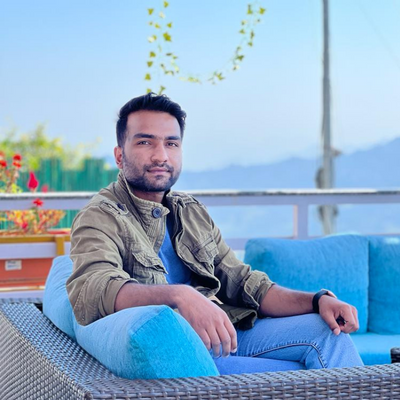
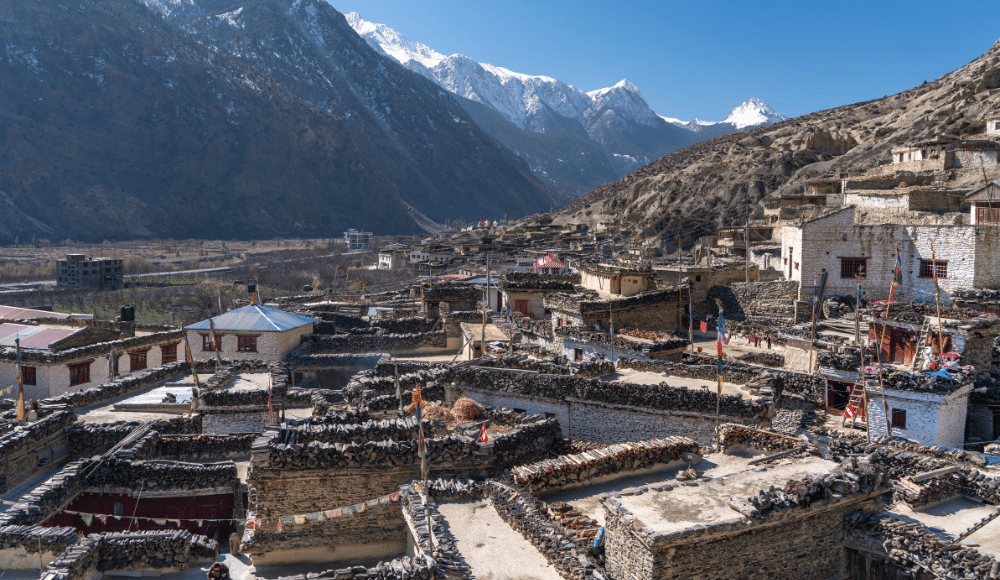
Nepal is one of the most beautiful countries in the world, and a once-in-a-lifetime opportunity to explore its rich culture, understated natural beauty, and diverse wildlife. When visiting Nepal, be sure to visit Mustang!
If you are looking for a holiday destination with an untouched and unspoiled natural landscape, home to an ancient culture that still carries on the customs of its ancestors, Mustang may well be just what you have been searching for. Located in central Nepal in the Himalayas at altitudes from 1640 m to as high as 8167 m at Dhaulagiri Summit, Mustang is an isolated region which has maintained its independence from modernity.
The mountains surrounding Mustang, especially the Himalayas, have been a source of inspiration for poets, writers and artists from many different countries. The landscape, so often compared to that of Tibet or Ladakh in India, has barrenness and roughness which is sharply contrasted by its beautiful open skies. This vast panoramic mountain scenery creates an ideal backdrop for the peregrinations of the ancient Tibetan Buddhist culture and way of life.
The Mustang district covers an area of 3,573 sq. Km in the Gandaki province of Nepal. It is one of the most beautiful places to visit in Nepal and is admired for its adventure, leisure and pilgrimage importance.
Mustang was an independent kingdom until the twentieth century. It was a landlocked, feudal monarchy with a history of isolation and autonomy stretching back at least 1,000 years. Upper Mustang was only opened up to the outside world in 1992 and foreigners were allowed to enter the area after obtaining a restricted area permit. Since then it has become a favorite destination for trekking and adventure tourists who come here to experience the culture and nature of this remote region.
Upper Mustang is one of the most untouched regions left in the world today. Due to its close proximity to Tibetan culture, the Upper Mustang is best preserved in its finest form. The dramatic scenery is highlighted by the snow-capped mountains that surround the valley. Tibetan styles largely influence the architecture of the buildings in Mustang. Several cultural monuments, ancient monasteries and structures are worth exploring in Mustang.
Mustang is a Tibetan word which means Plain of Aspiration. Jomsom is the headquarters of the Mustang district. It is well developed than other parts of the Mustang. There is an airport in Jomsom which acts as the main air accessibility to enter the Mustang district. Previously, Mustang was very remote, however, nowadays, progress in road infrastructure and accommodation facilities has made it a pleasing place to visit.
|
District |
Mustang |
|
Sub Regions |
Upper Mustang and Lower Mustang |
|
Administrative Headquarter |
Jomsom |
|
Province |
Gandaki |
|
Area |
3573 Sq. KM |
|
Rank |
5th Largest District of Nepal |
|
Highest Elevation |
5400 M with peaks rising to 8168 M |
|
Lowest Elevation |
1640 M |
|
Borders |
Manang (East), Autonomous region of Tibet, China(North), Dolpa (West), Myagdi (South). |
|
Accommodation Facilities |
Teahouse, Lodges, Hotels |
|
Accessibility |
Air, Road, Trek |
|
Protected Area |
Annapurna Conservation Area |
|
Major Tributary |
Kali Gandaki River |
|
Major Pilgrimage Sites |
Muktinath Temple, Damodar Kunda Lake |
|
Permits |
ACAP, TIMS, RAP |
Mustang is a beautiful culturally and naturally enriched place with an astonishing experience to offer. Mustang is a remote area in northwest Nepal, and a popular destination for adventure seekers, as well as anyone wanting to learn about the culture and history of this enchanting place. The Mustang region has breathtaking sights like the Kali Gandaki Gorge, the mystical Mani Walls, ancient monasteries and temples, barren landscapes and farmland in lower areas growing many types of crops such as buckwheat, barley, corn and peas.
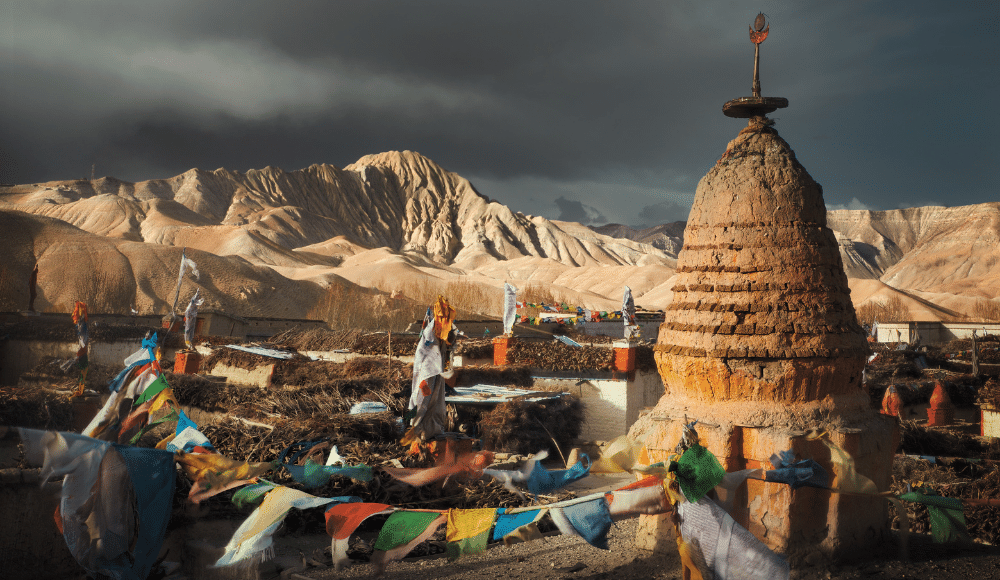
Mustang lies in the Gandaki zone of Nepal at an elevation range of 1640 M in Kopche Pani under Kunjo VDC to 8167 M in Dhaulagiri Summit. Besides the beautiful villages, it boasts an eight thousander Dhaulagiri and several other Himalayan peaks. With an area of 3573 sq. Km, Mustang district is the 5th largest district of Nepal in terms of area. The headquarters of the Mustang district is Jomsom and there are several hotels and lodges that offer accommodation facilities. The whole Mustang area is governed by National Trust for Nature Conservation (NTNC)’s Annapurna Conservation Area Project. The Mustang district is about 90 Km away from Pokhara.
The Mustang is a remote, independent Hindu and Buddhist religion spread over an area of 3573 square kilometers. The traditional culture in this area has been inherited for centuries and today there are about five rural municipalities belonging to this region that are scattered around the highland.
Mustang District, which borders the Tibetan Autonomous Region of China in the north, the Dolpa District in the west, the Manang District in the east, and the Myagdi District in the south, is located in the northwest of Nepal. The area is 3,563 square and has an elevation range of 1,372 m above sea level to 8,167 m above sea level.
Mustang, which is close to the Annapurna (8,091 M) and Dhaulagiri (8,167 M), is situated in the rain-shadow zone and is somewhat shielded from the effects of the monsoon. As per the report by Nepal Hydrological and Meteorological Research Center and Consultancy in 2015, the area receives relatively little precipitation, ranging from below 150 mm in Dhee, Upper Mustang, to 300 mm in Jomsom annually.
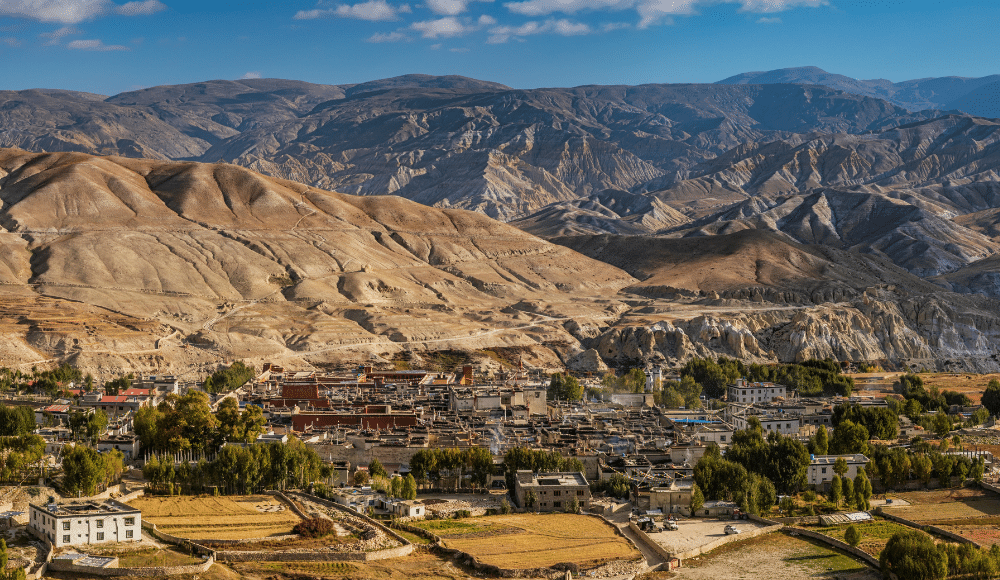
The entire district has been included in Nepal's largest protected area, the Annapurna Conservation Area (ACA), since 1992. The ACA Project is in charge of managing the area. The Mustang is subdivided into two areas: Lower Mustang and Upper Mustang.
Lete, Kobang, Tukche, Marpha, Jomsom, and Chuksang are significant villages. Muktinath, Ghami, Charang, Lo-Manthang, Surkhang, Chhonup, and other notable villages are also noteworthy. Muktinath is very important in terms of religion. Additionally, it is a well-known pilgrimage and tourism site.
Read More: Upper Mustang Tours
The Mustang District is a sparsely populated region in central Nepal, extending from the Hilly area of Myagdi all the way down to southern Tibet. It's a popular destination for trekkers, climbers, and adventure enthusiasts because it provides access to mountains above 3,000 meters.
This region's climate is influenced by the Himalayas to the Northeast, the Tibet mountains and a continental slope in the South. Snowfall is common in this area during extreme winters. Rainfall is comparatively less due to the trans-Himalayan properties. Therefore, the Mustang’s landscapes are arid and receive less rain.
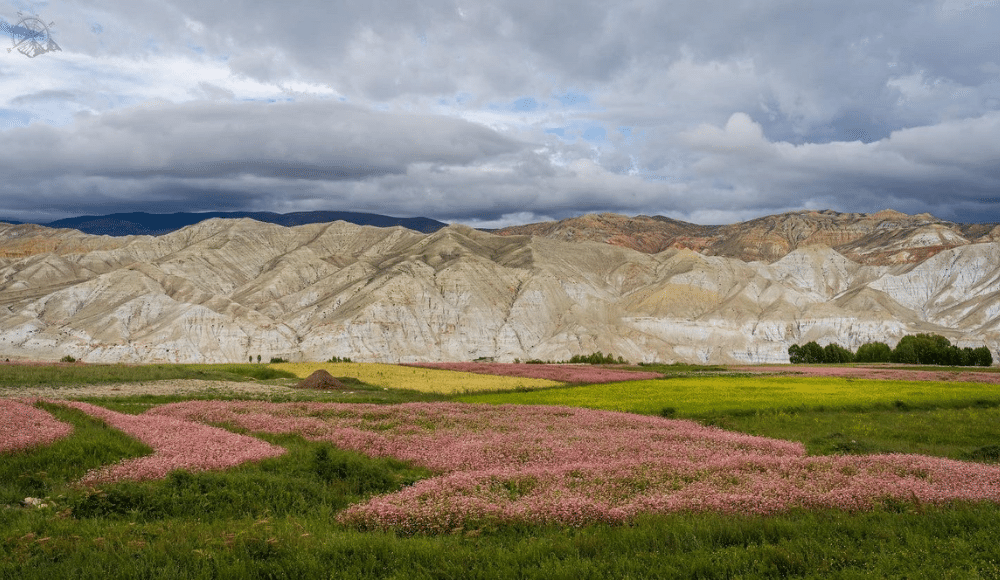
The average temperature ranges from -25° C during winter days, to 18° C during summer days. The best time for trekking in Mustang District is spring and autumn with clear skies and less snowfalls. You can expect temperatures above 10° C during spring, and above 12° C during summer.
A summary of the average temperature is provided here for reference.
|
Month |
Day |
Night |
Rain days |
|
Jan |
12°c |
2°c |
1 |
|
Feb |
15°c |
4°c |
4 |
|
Mar |
19°c |
8°c |
6 |
|
Apr |
23°c |
12°c |
9 |
|
May |
24°c |
14°c |
14 |
|
June |
25°c |
17°c |
12 |
|
July |
23°c |
17°c |
19 |
|
Aug |
23°c |
16°c |
17 |
|
Sept |
22°c |
14°c |
10 |
|
Oct |
20°c |
11°c |
3 |
|
Nov |
16°c |
7°c |
1 |
|
Dec |
13°c |
4°c |
1 |
SOURCE: World Weather Online
January: Around 12°C is the average temperature, while at night it feels like 2°C. There is about 1 wet day and 30.90mm of rain in January in Mustang. Nearly 47% of the air is humid.
February: The temperature is around 15°C during the day and 4°C at night. There are roughly 4 wet days and 67.48mm of rain in February in Mustang. It's close to 47% humidity.
March: Around 19°C is the average temperature, while at night it feels like 8°C. Mustang experiences 69.31mm of rain in March, with an average of 6 rainy days. There is nearly 41% humidity.
April: Even if it's only 23°C outside, it feels like 12°C at night. Mustang experiences 155.69mm of rain in April, with roughly 9 wet days. It's close to 42% humidity.
May: 24°C is the average temperature, yet at night it feels like 14°C. There are about 14 wet days and 256.52mm of rain in May in Mustang. It's close to 55% humidity.
June: Around 25°C is the average temperature, while at night it feels like 17°C. There are about 12 wet days and 343.51mm of rain in June in Mustang. It's close to 67% humidity.
July: Even though it's only 23°C outside, it feels like 17°C at night. Mustang experiences 730.01mm of rain in July, with 19 or so rainy days overall. It's close to 83% humidity.
August: The temperature is around 23°C during the day and 16°C at night. Mustang receives 573.67mm of rain in August, with approximately 17 rainy days. The humidity level is close to 83%.
September: The temperature is around 22°c during the day and 14°c at night. Mustang receives 266.55mm of rain in September, with approximately 10 rainy days. The humidity level is close to 79%.
October: A constant 20°C is experienced throughout the day, and 11°C at night. Mustang experienced about 3 wet days and 70.36mm of rain in the month of October. Nearly 64% of the air is humid.
November: Although it is only 16°C outside, it feels like 7°C at night. There is approximately 1 wet day and 11.08mm of rain in November in Mustang. There is nearly 59% humidity.
December: It is generally around 13°C during the day, and 4°C at night. Mustang experiences 12.16mm of rain and roughly 1 wet day in December. It's close to 51% humidity.
Very little of Mustang is covered in forest, and the majority of it is in the southern Mustang. As you move north, the size of the forest decreases. In less than 6 kilometers, the forest cover drops dramatically from Marpha to Jomsom, leaving the mountain slopes increasingly bare. The height and canopy coverage of the trees decline.
Except for a few wind-sheltered areas, the mountains north of Jomsom are virtually bare of trees. Such areas on the leeward side contain Juniperus and Betula tree species. The vegetation is sparse in high-altitude areas. In Mustang, there is a strong tradition of preserving the current forests, except for Lete, Kunjo, and Kobang, where the forest cover is rather dense.
Except for a few lone apple orchards away from villages, agricultural land is typically found around and near villages, taking up the lowest area. In contrast to other regions of the nation, only terraced benches in Mustang have adequate irrigation systems. Two crops are raised each year in the south. Though some maize and millet are also grown, they mostly consist of naked barley and buckwheat. In the north, only one crop is raised each year. Temperature and moisture stress are the main causes of the discrepancy in plantation growth.
Horticulture development has a very high potential in Mustang. Currently, it produces roughly 3088 tons of fruits, with apples making up 71% of that total. Currently, Mustang exports more than 800 tons of apples. Second, on the list of growing fruits, walnuts account for 23% of all fruits produced. Peach, apricot, grapes, pear, almond, and plums are some other fruits.
Mustang is an incredibly attractive place. What makes it more beautiful is the landscapes and culture and traditions of the local people. The lower Mustang is mostly dominated by Thakali culture. However, Upper Mustang has its own traditions that are mostly influenced by Tibetan culture. Some of the major attractions that make Mustang heaven are listed below.
|
Natural Beauty |
|
Arid Landscapes around the mountains |
|
Kaligandaki Gorge - Deepest Gorge |
|
Thakali Culture and Traditions |
|
Sky Caves |
|
Ancient Monasteries |
|
Festivals of Mustang |
|
Muktinath Temple |
|
Damodar Kunda |
Mustang is the conservative, remote, and mint place in Nepal. Sitting high in the mountain landscapes above 1500 m, it's a land of dramatic natural beauty with stretches of dense forests and miles of open terraced fields peppered by small ancient settlements. The region’s priceless cultural treasures date back to the 13th century and surround a kingdom that thrived for more than 700 years.
The Mustang region of Nepal is home to a handful of the most spectacular archaeological sites, many located in remote and mountainous areas which have never been explored by tourists. This can only be described as the Last Frontier.
The arid landscapes of Mustang Nepal are primarily composed of the Kali Gandaki River Valley, a basin formed by faults in the Himalayan Plateau that have been down-cut deeply by the river. Since the Mustang region receives less rain, the area is mostly arid and thus you can experience deserted landscapes in the mountains. The trans-Himalayan zone is the major reason that blocks the cloud from entering this area, thus making the settlement barren. It is also one of the least rain-receiving areas of Nepal even during monsoon.
The arid landscapes begin right after you enter the Tatopani and Kagbeni villages. The higher elevated areas are mostly arid. Also, the climate remains windy most of the day.
The Kali Gandaki River drains the entire area as it flows from north to south. The term ‘Kali,’ which literally means ‘black,’ comes from the river’s significant sedimentation. The tributaries cut through the mountains to the east and west as they almost perpendicularly join the river. The majority of human habitations are situated between 2100 and 4000 meters above sea level along the Kali Gandaki River.
The Thakali ethnic group has its roots in the Thak Khola area of Mustang District in the Dhaulagiri region of Nepal. The Thakali community's traditional home is in Thak-sat-se, which is part of the Mustang District and the Kali Gandaki river valley in western Nepal. With unique traditions for birth, marriage, and death, Thakalis have their own language and culture. Thakalis are very structured individuals. They maintain orderly homes and clean kitchens. The three main festivals celebrated by Thakalis are Lhafewa (Barha Barse Kumbha Mela), Toranlha (ancestor worship), and Falo (Kumar Yatra). The Thakali priest with the title of ‘Dhnom’ carries out the shaman's duties in the area. Their primary musical instruments are the Madaal, Khaprang, and Thamken.
The Thakali culture is also one of the major attractions to explore in the Mustang. Since they are the native to Mustang, the Thakalis still have the traditions and the culture intact. Their way of life and celebrations of festivals are unique. They also offer wonderful hospitality to the people visiting the Mustang of Nepal.
Mustang Monasteries are believed to be the oldest unmolested group of buildings in Nepal, still inhabited by monks and used for religious purposes. The monasteries were built with the most basic construction materials: stone, timber, earth and metal. Many are built at altitudes exceeding 3000 m. with no mechanical or technological assistance whatsoever. There are numerous monasteries to explore in Mustang.
The Sky Caves of Nepal are an intriguing feature of the Mustang region and are cliff homes built into the sides of valleys. A story can be deciphered from the discovery of bones and partially mummified human remains, as well as from the discovery of priceless Buddhist artwork, antiques, and manuscripts from these Sky Caves. It is said that the caves were used as burial chambers as early as 1,000 BC. The area was fought over in the tenth century, leading people to choose safety over convenience. The caves were inhabited by families who had settled there. As people began to live in settlements around the 1400s, the caves served as meditation spaces, military lookouts, or storage areas. The stories of the development of these caves are also backed up by some scientific research and oral traditions. These cliff cave systems are important aspects of Mustang to explore in Nepal.
There are numerous festivals that are celebrated in this mountain region. The festivals that Mustang celebrates are unique and carry a huge cultural association and religious proximity. While the most famous festival in Mustang is the Tiji Festival, there are many others that are worth checking out. The Yartung festival, for example, is a chance to revel in Nepali culture as well as make new friends from remote Nepal. The festivities are organized in the remote settlement that enables the visitors to explore a vivid dimension of cultural dominance in rural Nepal.
In the Annapurna Conservation Area of Nepal, there is a small area that is considered to be sacred: the Muktinath Temple. Muktinath means ‘sacred place’ in Sanskrit; it’s also called Mukti Kshetra.
One of the most sacred Hindu temples in Nepal, this is a large complex built over a cliff of limestone rock. Muktinath is situated at an altitude of 3710 m and has located in the remote Mustang District of Nepal. The word ‘mukti’ means freedom or salvation and Muktinath is considered to be the most sacred place in Nepal.
The temple is dedicated to Lord Vishnu and is considered sacred by Hindus and Buddhists. This temple also boasts an incredible religious symbiosis as Buddhists also consider it a place where Padmasamvaba meditated on his way to Tibet.
Located in the Mustang District in Western Nepal, Damodar Kunda is a very significant Hindu Pond. In a very remote area of Mustang at a height of 5,400 meters above sea level, this place is both challenging and exhilarating to reach. The view you get to see here is quite breathtaking despite the challenges. You can see the Tibetan Plateau from here because it is closer to the Tibetan border. You can also explore the breath-taking views of the Himalayas, including Damodar Himal, Annapurna, Nilgiri, and Dhaulagiri. The restricted Upper Mustang and the former Buddhist Kingdom of Lo are also accessible from the Damodar Kunda.
Mustang is subdivided into two areas: Upper Mustang and Lower Mustang. Both the places are incredibly beautiful with their distinct geographical and cultural attributes. Mainly the culture and ethnicity separates the beauty of these two beautiful parts of Mustang. The lower Mustang has Thakalis dominance whereas people of Upper Mustang have their own culture and traditions that are more inclined towards the Tibetan values and lifestyle. The lower Mustang has a mixed population whereas the Upper Mustang has a dense ethnic population that have resided in the Upper Mustang’s vicinity since centuries.
Mustang lies in the Annapurna Conservation Area, a project initiated to conserve biodiversity and fuel sustainability goals. To enter the Lower Mustang area, travelers need to obtain ACAP and TIMS permits. However, Upper Mustang is a restricted area and needs a special restricted area permit to enter.
What do you get when you cross a Tibetan village, an ancient fort, and a rainforest? You get Upper Mustang in Nepal. Upper Mustang is the name given to one of Nepal's remote and restricted areas. It is located on a high plateau surrounded by beautiful mountain peaks and treeless valleys. This area is also home to the ancient Loba people who still follow their religion without interference from outsiders.
The people are a mix of Mongolian and Tibetan descent who moved to this area hundreds of years ago. Upper Mustang is their home and they have fiercely protected it from intruders for centuries. Upper Mustang has only recently been opened to tourism, and is a very unique area. Located in the Annapurna region of north-central Nepal, it is one of the most isolated valleys in the country. It's so remote that it was an almost exclusively Tibetan village for centuries, until Nepal's borders were opened to outsiders. There are even remnants of a Tibetan dialect still spoken here by locals! The people here are the descendants of immigrants from Tibet who fled to these hills over hundreds of years ago.
Upper Mustang was demilitarized until 1992, making it one of the most protected regions in the world. This part used to be an independent kingdom until 1795. It was annexed in Nepal by the Kingdom of Nepal and has been under the sovereign territory of Nepal since then.
The Upper Mustang is a restricted area that requires a restricted area permit to enter. To protect the cultural authenticity of Upper Mustang, the government decided to restrict the movement of people and only with special permits foreigners are allowed to enter these areas. So, a special permit is required to enter the Upper Mustang of Nepal.
In Nepal's Western Himalayas, in the Upper Mustang region, there is a small medieval walled hamlet called Lomanthang. It is situated in a small valley at an elevation of 3750 meters close to the Nepal-Tibet border. Historically, this area was a province of Tibet that later split off to form the kingdom of Lo. The fortified city of Lomanthang served as the seat of the Kingdom of Lo. This kingdom finally fell under the control of modern-day Nepal in the middle of the 18th century. Prior to the restoration of multiparty democracy in Nepal in 1990, Upper Mustang was a restricted territory. The region was made accessible to organized tourists by the Nepalese government in 1992. Upper Mustang's tourism is overseen by the Annapurna Conservation Area Project (ACAP).
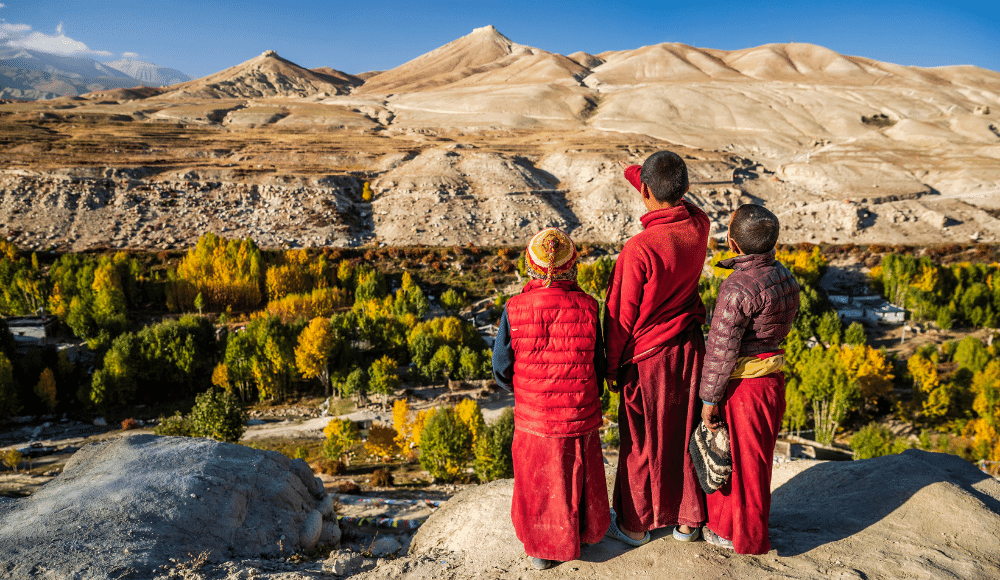
The most distinctive region, Upper Mustang, merits designation as a Cultural Landscape. The villages are dispersed throughout the area and include Buddhist monasteries, century-old strongholds called Dzong, and palaces in addition to adobe homes and caves in the cliffs. Numerous of these monasteries, with their extensive religious and cultural histories, are preserved in their finest form. Traveling to Lomanthang opens up the opportunity to witness varied landscapes and centuries long historical facts. The monasteries and buddhism in Lomanthang is unique to this place. So, besides its incredible ancient royal foundation, the place is one of the most beautiful places in Nepal to explore.
Upper Mustang can be reached by trekking in the mountains. Passing through villages and barren fields, Upper Mustang is easily accessible. However, another option that makes the trip shorter is to take a flight to Jomsom from Pokhara and then take a jeep ride to Upper Mustang. It dramatically shortens the travel period and you can also enjoy what this remote beauty has to offer.
|
Permit (RAP) |
Permit Fee |
|
Lomanthang Rural Municipality (All areas of ward no. 1 to 5) Lo-Ghekar Damodarkunda Rural Municipality (All areas of ward no. 1 to 5) Baragung Muktichetra Rural Municipality (All areas of ward no. 3 and Satang Village of ward no.5) |
USD500 per person (for the first 10 days) USD 50 per person /Day (beyond 10 days) |
What might be the most fun thing to do in Mustang, Nepal? There’s more than one answer to this question. If you have any plans of visiting the country, then you may want to know about the various festivals taking place there.
Upper Mustang has one of the best preserved cultures and traditions. The festivals that are celebrated in this part of Mustang are very unique. The festivals are culturally and religiously motivated and have been in practice for centuries. These festivals depict the history, culture and lifestyle of people of Mustang region. Tiji Festival and Yartung festival are the popular ethno-cultural festivals that provide a brief introduction to the history and the cultural inheritance that has been carried out in Mustang for centuries.
Upper Mustang's Lomanthang hosts the Tiji Festival. The Tiji festival is thought to have originated in Lo Manthang during the reign of Lama Lowo Khenchen, one of the greatest Buddhist teachers and a son of King Amgon Sangpo, in the 15th century. The chasing of the devils, a three-day ritual, is performed here.
The festival is centered on the Tiji myth, which narrates the tale of a god by the name of Dorje Jono. To prevent the ruin of the Kingdom of Mustang, he engages in combat with his demon father. Villagers from the Loba tribe congregate in the capital to take part in masked dances, make prayers, and mark the beginning of a new season. One of the most well-known and cherished events in the entire Mustang region is this three-day annual festival held in Lo Manthang in front of the King's palace.
The Tiji celebration, according to the Mustangi people, is meant to bring them hope, serenity, and protection from evil powers. It is based on the legend of a god named Dorje Shunu, also known as Vajrakila, who underwent reincarnation in order to defeat all the evil entities and demons responsible for misery and suffering on earth. The deity vanquishes the demons and brings peace and prosperity to the country via the might of the Tiji festival dances and the variety of forms he assumes. The event thus represents the triumph of good over evil.
The Yartung festival is observed across Mustang, although it is most popular in Muktinath on the full moon day in August each year. Horse races, drinking, and dancing are all part of the three-day event, which is held by the Thakali community in the area.
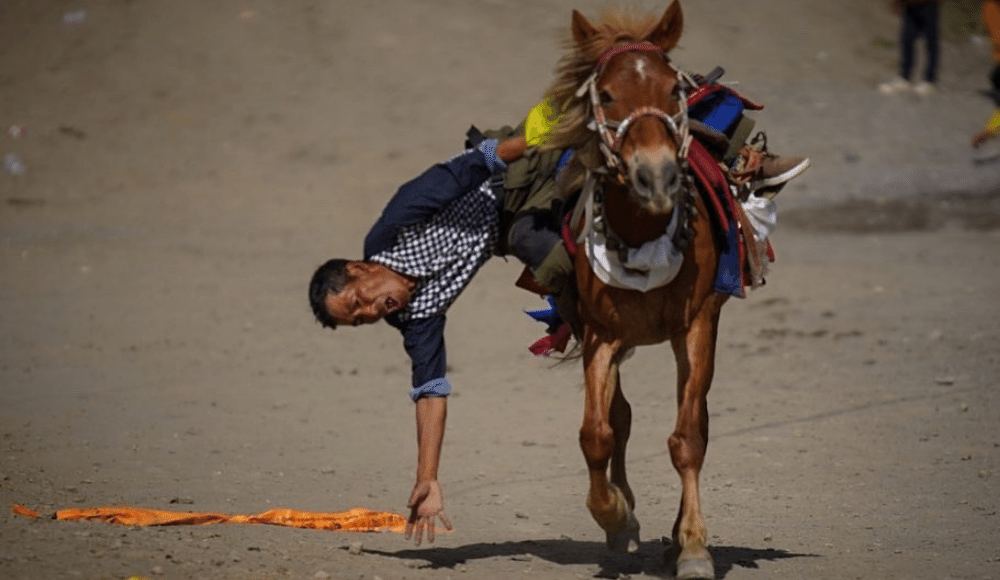
The first of the three days of the festival is dedicated to the local ruler, the second to the monks, and the third to the local inhabitants. The horse race rivalry between men and women is the most alluring activity at this festival. Yartung is their word for the end of the summer. It is also celebrated to commemorate the beginning of beautiful Autumn bidding farewell to the Summer season. In some instances, the Yartung festival is also taken as a harvest festival in Mustang.
There are numerous teahouses and guest houses built that host the visitors. The local hospitality is the key aspect to explore in the Upper Mustang. The homestays and lodges offer a wonderful insight into tourism and its impact on the life of people. What makes it more interesting is while staying in the available facilities, you can talk with locals and understand the way of life. The cultural attributes are very authentic and provide an amazing experience through its cultural aspect in remote settlement.
Lo Manthang is located about 50 kilometers from Jomsom, the Lower Mustang's administrative center, and around 100 kilometers from Pokhara, one of the biggest tourist cities of Nepal.
The region has limited but growing access. Jomsom, which was formerly the starting point of a trekking route that encircled the Annapurna highlands, is still the closest airport. Although the airport was constructed in the 1960s, Lo Manthang tourism was only permitted in limited quantities after March 1992.
Road access was only feasible once Jomsom and Lo Manthang were connected by infrastructure development in the middle of the 2010s. Lo Manthang can now be reached by road, however access is severely constrained by the weather, and road closures are often. Jomsom is a 4–8 days' hike from Lo Manthang.
The Upper Mustang is accessible via trekking and drive route. Some off-road and some well paved paths take you to the Lomanthang in Upper Mustang. On the way, you can explore the monasteries, cliffs, sky caves and numerous other attractions. The best part about getting to this place is its beauty that has been best preserved since centuries.
Lower Mustang is also a historically and culturally rich area. The Kaligandaki river, Muktinath Temple, Jomsom, Kagbeni, Tatopani etc. marks the major places that provide an impeccable remote and cultural experience just about 100 Km away from the Pokhara valley. It is also one of the popular motorbiking areas that observes thousands of visitors every year. Despite having a combined identity of Mustang that includes Upper Mustang as well, Lower Mustang is quite different in terms of cultural experiences from Upper Mustang.
The Jomsom is one of the popular places in Mustang. It is also the headquarters of the Mustang district. It lies in the lower mustang area and is mainly popular as a place where air accessibility is possible. The lower Mustang observes a lot of trekkers, pilgrims and adventure enthusiasts. It is also a paradise to explore the raw beauty of arid valleys and unspoiled landscapes.
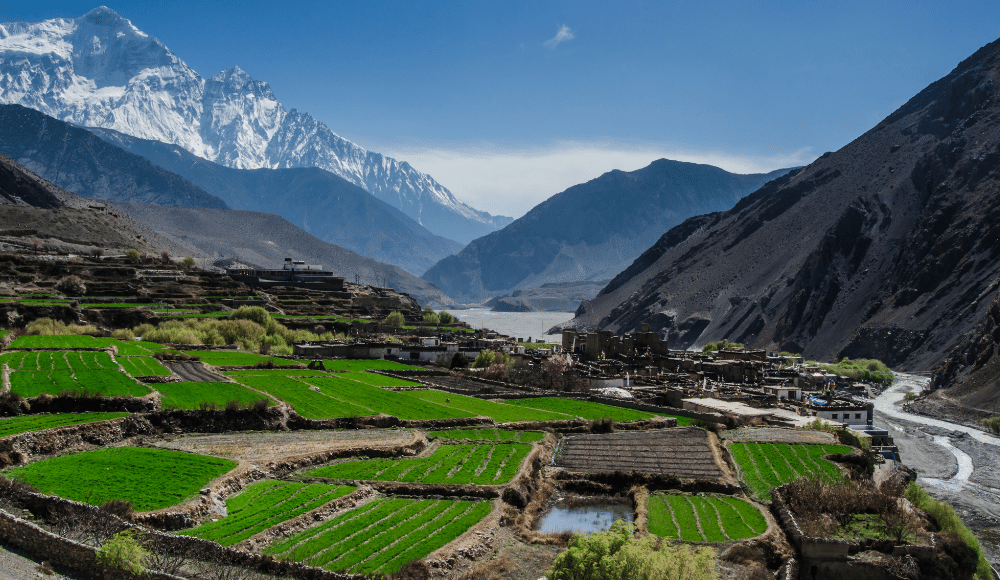
The mustang is surrounded by arid deserts, prehistoric rock-cave dwellings, and Buddhist traditions. The Kali Gandaki River is one of the major attractions of the Mustang village. The distance between the river's height and the tallest peaks on either side yields the Kali Gandaki Gorge, also known as Andha Galchi, as the deepest canyon in the world, which is also located in the Mustang region. The Mustang community, which is surrounded by beautiful natural scenery, is also a haven for various wildlife and plant species.
The Mustang town has a rich cultural legacy and beautiful temples and monasteries that are incorporated into the lunar-like backdrop. It also boasts a wide floral and faunal attractions from its lower parts to the high trans himalayan landscapes. So, the chances are you can explore a wide range of topographical differences, cultural uniqueness and natural authenticity in this mind blowing place.
Kagbeni is situated in the Mustang district of Nepal's natural High Mountain area. In addition to being situated along a well-traveled trekking route around the Annapurna Mountain Range and being connected to the rest of Nepal by a new road in 2008, Kagbeni village offers a wonderful cultural experience with its cluster of houses and beautiful natural landscapes.
The single Gateway to Upper Mustang called Kagbeni, is situated in the Kali Gandaki River Valley. It has a rich history and wonderful settlement that never fails to amaze the trekkers and visitors with its mind blowing natural attractions. This beautiful village has a total area of 58.3 Sq Km and is located 2,804 meters above sea level.
The climate and topography are comparable to the Tibetan Plateau and can be chilly, windy, and dry due to the Greater Himalayas’ rain shadow. In the Kagbeni village, there are numerous experiences such as mountain biking, cultural exploration, religious shrines visit and trying the local wine. The apple farms alongside adds more attraction to this place. It is also a beautiful place that lies in the trekking routes of Mustang and Annapurna Circuit.
In Nepal's Mustang region is the charming village of Marpha. The hamlet is a popular destination for tourists and is situated at an elevation of 2650 meters in the Kali Gandaki Valley of the lower Mustang area. The name Marpha is made up of the two syllables "mar," which means diligent work, and "pha," which means individuals. One of the few sites, Marpha, is where tradition and modernity coexist harmoniously. There are several attractions to explore in Marpha such as Apple Farm, Local Distillery, monastery visit, hills around Marpha and cultural authenticity of local people.
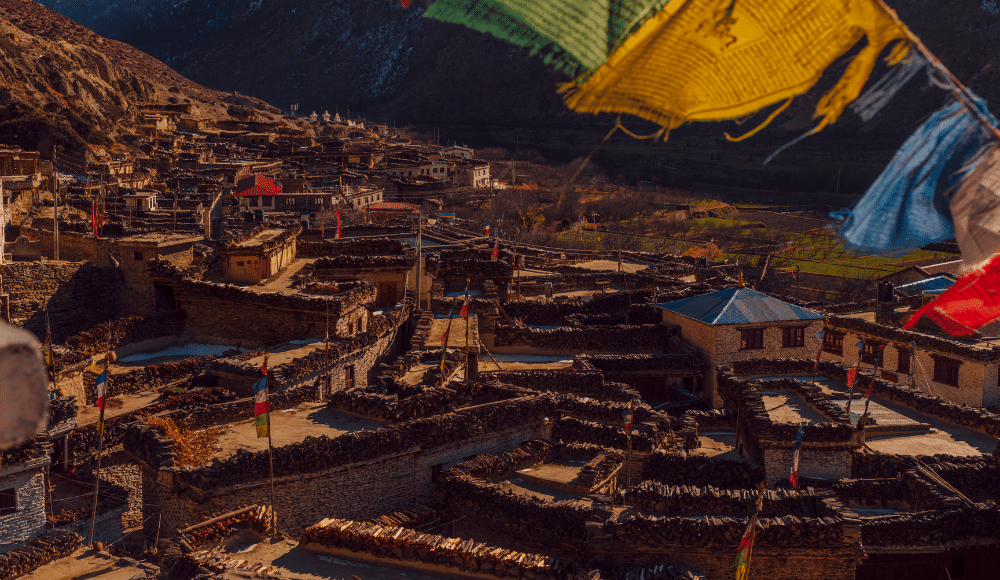
One of this village's most beautiful and popular walking routes are the narrow lanes of Marpha. This village's tidy, stone-paved strolling thoroughfare amply demonstrates the distinctiveness of the Thakali cultures in the area. You can also witness the cultural belongingness and the lifestyle of people that is integrated by the religious values in this place.
Muktinath is a holy place dedicated to Lord Vishnu. This sacred space is situated at an elevation of 3749 m above sea level and offers a wide range of cultural, natural and religious attractions. This place is revered by Hindus and Buddhists.
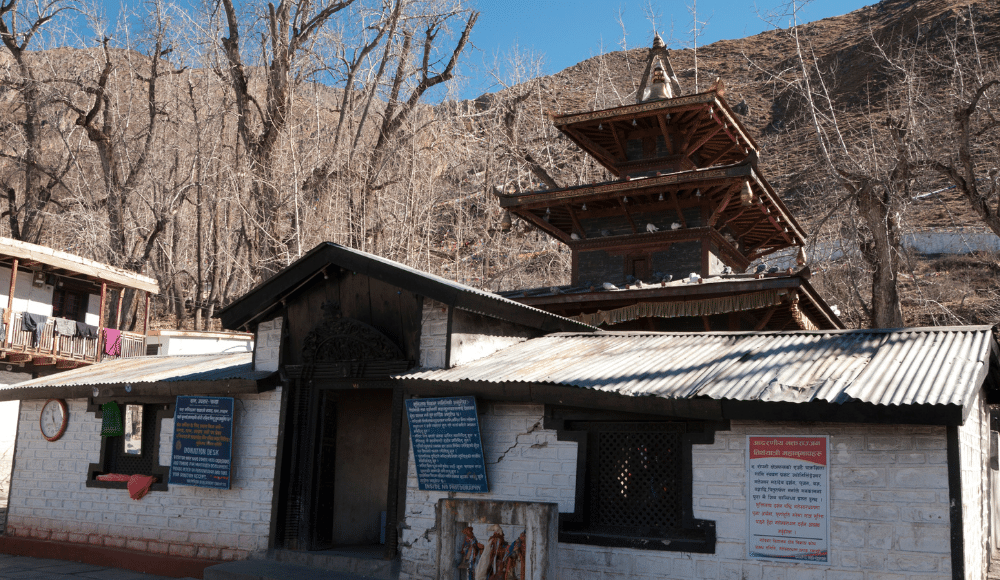
The Muktinath Temple (Chumig Gyatsa) is a representation of the interreligious harmony between Buddhists and Hindus. The Hindus hold that this is where Lord Vishnu found deliverance from Brinda's curse (Jalandhar's wife). He is hence revered as Muktinath. It is about 21 Km away from Jomsom. The spiritual magnetism of this place attracts thousands of Hindus and Buddhists every year.
Getting to Lower Mustang is super easy. A flight from Pokhara to Jomsom lands you in the district headquarter Jomsom and you can explore the beautiful Lower Mustang by strolling around the village. A jeep drive is also accessible that takes you to Mustang from Pokhara city. From Pokhara it takes about 6 hours to drive to reach Jomsom. However, if you are taking the flight route to Jomsom, it takes merely 20 minutes to reach there.
Mountain biking, Motorbiking, Trekking or Jeep drive could be some other options to explore the lower Mustang area. You can enjoy the natural splendors of this place and explore the diversity of nature and culture throughout the trip.
|
Permit |
Permit Fee |
|
TIMS |
USD 10 (Organized Trek) USD 20 (FITs) |
|
ACAP |
USD 10 (SAARC Nationals) USD 27 (Foreigners other than SAARC) |
There are ample hotels and teahouses that offer accommodation facilities in Jomsom. You can stay in a lodge and teahouse in different places. Due to the increasing tourist flow, there are numerous hotels and facilities that host the travelers. The scattered settlement provides an insightful experience in the village. Also, you can enjoy the local hospitality that is solely offered by the people of Mustang.
The road infrastructure from Pokhara to Jomsom connects the lower Mustang. The road passes through places like Tatopani, Kagbeni, Marpha, Jomsom and Muktinath. On the way, you can enjoy the beautiful landscapes and natural beauty. Air accessibility connects Jomsom with Pokhara. The small flights offer the accessibility service in Mustang. Also, helicopters also provide the transportation facility in Muktinath and other places.
Mustang is an incredible land of mysteries. It has a history that dates back to centuries. The unique culture, landscapes and religious attributes made this place a wonderful haven to visit in Nepal. The areas of Mustang are mostly arid due to the trans himalayan shadow zone. Due to this reason alone, the Mustang is known as the desert of Nepal. There are many activities to do in Mustang and many attractions to explore. This place is known to have some mysterious caves and historical artifacts. Mustang is also popular for pilgrimage, trekking, mountain biking and nature and culture exploration.
Trekking is extensively admired in the Mustang region of Nepal. It enables the trekker to explore the multiple dimensions of life, nature and heritages. Nepal’s Mustang region is a spectacular and relatively known part of the Annapurna circuit, perfect for trekkers looking for a more intimate experience. The landscape is characterized by steep, grassy slopes dotted with Tibetan-style chortens and swathes of terraced rice paddy in the valleys below. Trekking to Upper Mustang, Muktinath and Annapurna Circuit is popular. The Dolpo trekking can be extended from Mustang.
Out on the trails of Mustang you'll find nothing but natural beauty. The rewards are there for those who are willing to trek hard enough and brave enough. Renowned for being one of the most rugged and beautiful regions of Nepal, trekking in Mustang offers a life-changing experience which will stay with you forever, so what are you waiting for? Get out there, explore that wild side!
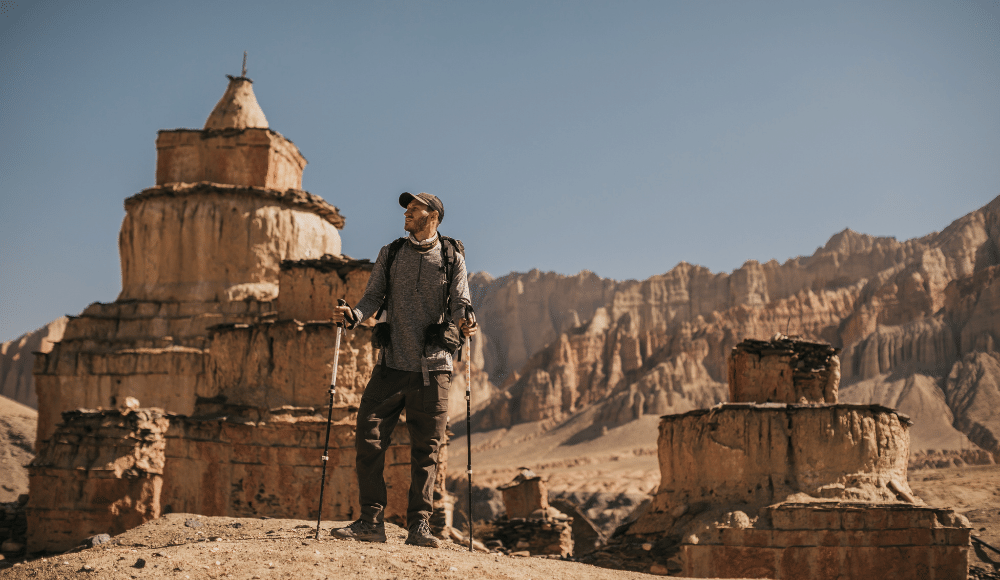
As with any trip to a new country or region it is important to do some research before setting off on your journey. Mustang has a great deal of trekking options which are best, planned in advance and researched thoroughly.
It is important to remember that Mustang is not a trekking region for the faint hearted. Its high altitude and unpredictable weather can be a challenge for even experienced trekkers. So, a moderate difficulty is there. However, the treks in this region are doable and there are many options to choose from.
The best time to trek in Mustang Nepal is usually during the summer months of March-April and October- November. The weather is usually mild, but fairly unpredictable at certain times of the year, so it's a good idea to check expected weather before leaving home. For information on the suitable time to explore, visit Best time to visit Mustang. The weather in Mustang is unpredictable so the best thing to do is check the forecast and plan the trek accordingly.
Mountain Biking is a popular activity in the Mustang district of Nepal. The Mustang region of Nepal is home to the high mountain bike riding in Asia. It's a land of remote villages, picturesque Nepalese farmlands, and ancient monasteries that are high on the hillsides. The coolest aspect? The best biking trails are usually situated next to a particular ethnic group. All around, you'll see the people's customs and handicrafts as you ride through their villages and past their homes.
The best way to start your adventure is either from Kagbeni, the heart of Mustang, or Jomsom, a lively town which offers numerous opportunities for trekking and mountain biking or Pokhara itself. You can also fly here from Pokhara. The most popular season for biking here is September to June.
Mustang's nature has always been wild and untamed. This is the region of Nepal where horses still outnumber cars. You'll find more than a dozen ethnic groups, spectacular mountain scenery and the famous Tibetan culture that's set amidst valleys, high-altitude plains and barren hills.
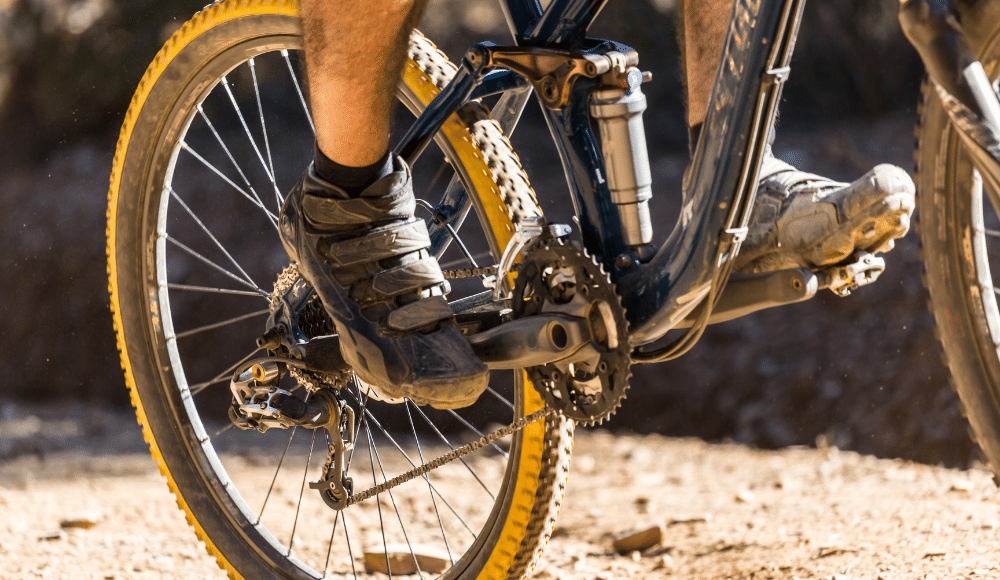
The best time for mountain biking in Mustang is fall (September till November) has less rain or even none at all and spring (March till May) when temperatures are mild yet trails are not muddy. However, Mustang observes the least rainfall even during monsoon, so, it could be the perfect spot for year round Mountain Biking in Nepal.
Jeep Drive is also a popular way to explore Mustang. The road way is accessible all the way to Upper Mustang from Pokhara. However, in such a terrain, only 4WD drive is a possible alternative. So, if you are planning to go on a Jeep drive, you could use that and enjoy the majestic mountain views, scenery and explore the vivid spectrums of the virgin mountains. It could be a detailed account of incredible mountain land across the barren land, valleys, and high mountains of Nepal.
Put your hand on the wheel and feel the experience of driving through remote landscapes were horses, mules, and herdsman are common and you can witness the close bond between the livestock and human beings. Jeep ride is also a wonderful way to explore this beautiful mountain land in a short time and without getting into the hassle of walking.
This is a place of amazing beauty and history where the people are known for their hospitality and wisdom. This tour will have you visiting the famous Mustang villages, pilgrimage sites, water springs, flora and fauna. You will observe a village life of beautiful people who live in harmony with nature. Also explore the hot spring in Tatopani where local shepherds gather before they start the journey back to their home places.
Honor and adventure lie waiting at Mustang. Whether you are craving a thrilling ride down the Kali Gandaki Valley or a quieter trip to Kagbeni or Tatopani, Mustang is the honor of Nepal’s northwest corner. Once home to Tibetan Buddhists, this rugged region is now home to herds of wild horses and an open range of incredible Himalayan views. Take a motorbike tour across these treeless plains and witness firsthand what makes Mustang so special.
Castellated peaks, gushing rivers and the Valleys beyond are just a few reasons why Mustang is one of the most revered geographical areas in Nepal. If a glimpse into this wild place doesn’t make your heart pitter-patter, then maybe the thrilling ride down the Kali Gandaki Valley into Jomsom will. These are some of the most stunning Himalayan panoramas you will experience while visiting Mustang, and they’re easily accessible by motorbike.
Adventurous motorbikers rave about the thrilling ride down the Kali Gandaki Valley from Jomsom to Kagbeni. The trip is one of Nepal’s most stunning mountain roads and an incredibly fun way to get around Mustang. Along the way you will pass homesteads and terraced rice fields, red-roofed monasteries and rock carvings dating back over a thousand years.
In today's society, there is a renewed interest in all things related to our past. Whether it is young people trying to find traces of their ancestors, or just plain old history enthusiasts looking for new facts and records, we are all seeking some way to connect with those who came before us. One answer comes in the form of Mustang's culture; a true treasure that has been preserved since the first Tibetan settlers arrived in the valley of Mustang and Thakalis evolved from Thak Khola. When they migrated and evolved, they brought with them a rich, multi-layered culture that had been shaped by the geographic determinants and political struggles that Tibet had to face over many centuries.
Ancient Tibetan culture is strongly influenced by three elements: Buddhism, which has permeated all aspects of life in some form or another since the advent of Buddhism in Tibet, Bon (the ancient pre-Buddhistic religion of Tibet) and Shamanism. Buddhism is the primary influence in Tibetan culture, and there is a saying in Tibet that ‘everything is permeated by Buddhism’. Of the three influences, Buddhism has been most influential on Mustang;s culture and traditions. Buddha relics are very important in both Mustang's monasteries and villages, as they are believed to bring good luck and protection. Also, a mixed population can be seen in the lower Mustang part. So, you could explore a diverse range of cultural population in the Mustang region of Nepal.
There’s not many places on Earth that will make you feel like you’ve gone through the looking glass. Mustang, Nepal is one of those rarities. This place will convince you that you might have just exited the movie theaters or embarked on an epic journey in some fantastical world where things are only barely starting to come into focus.
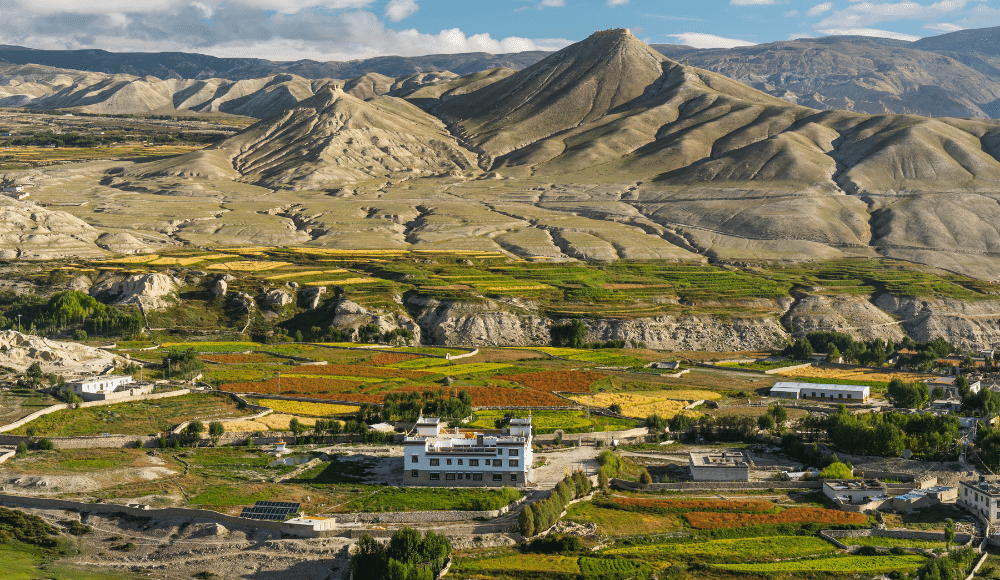
Mustang is where the past becomes the present, and where you can still hear echoes of ancient settlers from all corners celebrating in their own ancient ways. It’s the kind of place that will make you question everything you thought you knew, and where it doesn’t even matter if what is so blatantly in front of your eyes isn’t even real. The barren landscapes and sky caves in the cliffs of this land are surreal. As you move higher, you can explore the people who distinctly adore the culture they are passed on with. So, the nature and culture dimension of Mustang is the best part that makes this place tremendously beautiful.
Nepal is a country that has taken great interest in religion and culture. It's a home to lots of people from different religions because there are so many faiths present. One of the most common reasons for people to travel is to experience new things, and what better way to explore a new place than by visiting its sacred sites? When it comes to Mustang Nepal, there are many things that make this place one of the most visited in Nepal. For example, one such site is Muktinath Temple. It is known for the Hindu and Buddhist religious symbiosis and venerated by the followers. The Damodar Kunda in the Upper Mustang area is also popular. It also has some religious significance. There are numerous monasteries in Lower and Upper Mustang that are known to have some Buddhist significance. So, Mustang is a popular pilgrimage center that provides incredible religious attributes to the visitors.
Mustang is a trekkers paradise. There are numerous trekking trails popular in Mustang region. So, you could pick one to quench the thirst of exploring the beautiful landscapes of Mustang region in Nepal.
The shorter version of Nepal's traditional Annapurna Circuit Trek is known as the Short Annapurna Circuit Trek. It is the perfect option for adventure hikers who want to visit the most well-known trekking trail in the Annapurna region but are short on time. The highest point of the Annapurna Circuit Trek is the Thorong La Pass. After passing via the Thorong la Pass, you may get to the Muktinath Temple in the Mustang district. Along the walking paths, you can also tour several old monasteries and pass through rural communities. You will later emerge into the Kagbeni or Jomsom. For details, visit Short Annapurna Circuit Trek.
The last forbidden kingdom on the country's territory can be reached via the Upper Mustang trek. It serves as the entrance to the enigmatic realm of the former Buddhist kingdom of Lo, which served as Mustang's first capital. Up until 1992, common travelers could not access Upper Mustang. It was consequently totally cut off from the outside world. Currently, restricted permits, TIMS cards, and ACAP permits are needed to explore Nepal's Upper Mustang.
One of the most well-liked tourist spots in Nepal is Mustang. The Upper Mustang trek doesn't need any technical climbing. In the meanwhile, the trek's degree of difficulty is moderate, making it simple for beginners with average levels of physical fitness to accomplish. For details, visit Upper Mustang Trek.
One of the most challenging treks in Nepal is the extreme upper Dolpo trek from Mustang. The journey begins in Mustang's Jomsom and concludes in Nepal's Dopa region at Juphal. You will cross several of the high passes that are located inside the Dolpo region of Nepal on your extreme upper Dolpo nine passes trek. One of Nepal's untrodden and unknown trekking routes is the route we use for our challenging upper Dolpo nine-pass trek from Mustang.
Extreme hikers without prior hiking experience should avoid the upper Dolpo Nine Passes journey to Mustang. The hike is challenging mostly because of the nine high passes that it includes. For details, visit Upper Dolpo Trek from Mustang.
A picturesque tour of Nepal's Mustang region is offered to tourists on the Upper Mustang 4WD Jeep Tour. One of the most stunning spots to explore in Nepal's remote Mustang region is Upper Mustang, originally the exiled kingdom of Lo. It is well-known for its untainted landscapes, dry valleys, and the Thakalis and Tibetan residents of the Upper Mustang who uphold their cultural and traditional beliefs.
In Nepal, Upper Mustang is situated in a dry area because of the trans-Himalayan topography. The breathtaking cliff-faced scenery and arid atmosphere of this location are among its main draws. The Upper Mustang 4WD Jeep tour is the ideal way to see the mountain vistas, Tibetan culture, and traditions, as well as the magnificent Jeep drive and lovely mountain valleys. For details, visit Upper Mustang 4WD Jeep Tour.
Looking for a fresh experience to distract you from the mundane grind of daily life? Trekkers, mountain climbers, and others will find plenty of adventure and exploration options in Nepal. The Lower Mustang Royal Enfield Motorcycle Tour is one such adventure in store for you!
Motor bike aficionados will get the chance to visit seldom visited villages and mountain valleys on this vacation in western Nepal's isolated Mustang area. You could get to converse with residents and enjoy a meal while seeing the villages. In addition, you can bike through the breathtaking landscapes and take in the breathtaking Himalayan views.
As they ride through the area's hills, riverbanks, and valleys, motorcyclists will experience some of Nepal's most breathtaking scenery. Bikers will get the chance to encounter Thakali culture directly as they go through this amazing alpine region while riding in Lower Mustang. The best time of year to go on this journey is from March to May, July to September, and early November to December. For details, visit Lower Mustang Royal Enfield Motorbike Tour.
Get in touch with our experts right away and finalize an experience!
About UsMustang, Nepal is a beautiful place steeped in history and tradition. Lying in the lap of the Himalayas, Mustang was once a prosperous place known for its culture and traditions. If you're about to start planning your next adventure, then you'll need to know when to go. And while it's always a good idea to make the most of your travel time, you'll want to make sure you pick the best season to visit. The Spring, Summer and Autumn are the best seasons to visit Mustang as the climate is dry and clear. In winter, the snowfall can make the experience harsh. Monsoon also can be harsh due to landslides in different places in the lower parts of Mustang. For detailed information on the best time to travel, visit Best time to visit Mustang.
In order to properly prepare for your trek it is essential that you acquire essential items in advance. This can be anything from a compass, map, good backpack and diamox tablets. Update your packing list and create a checklist for your trek backpacking. There are many uncertainties and challenges with planning a great backpacking trip such as Trekking around Mustang in Nepal. There are few essential items that you are going to need for all the amazing adventure that lies ahead. The list includes basic necessities such as clothing, equipment, and of course food! This should help you plan ahead for your trekking adventure in Nepal. For the information on what to pack, visit Nepal Trekking Gear Checklist.
For most people, hiking a mountain or trekking across an exotic country is the adventure of their lifetime. But it's not always as easy as they might think. There are certain guidelines and dos and don'ts that should be followed when you're out on your trip to ensure that you make it back home without any fatalities. Here are some guidelines and dos and don'ts to follow when you're out in the hills.
We know that no amount of advice can prepare you for what lies ahead and there is always a chance of something going wrong even if all your preparation was perfect. You may not be prepared for everything but at least these simple guidelines and dos and don'ts would help reduce any unnecessary risks during your hike or trek in Nepal.
Do carry a first aid box with all necessary medicines.
Do carry a good quality torch that is waterproof and works effectively in low-light conditions.
Bring items that are reusable. Do not litter.
Respect culture and traditions.
Namaste is the welcoming gesture of Nepalese. Respond back with the same.
Try to be nice with locals and don’t get into conflicts with others.
Don't consume carelessly. Be cautious with food and water.
The temples and monasteries are the religious heritage of Mustang. Respect the pilgrimage and local traditions.
Be mindful of what you wear. In the isolated Upper Mustang and wearing shorts.
our first-hand Himalayan travel experience